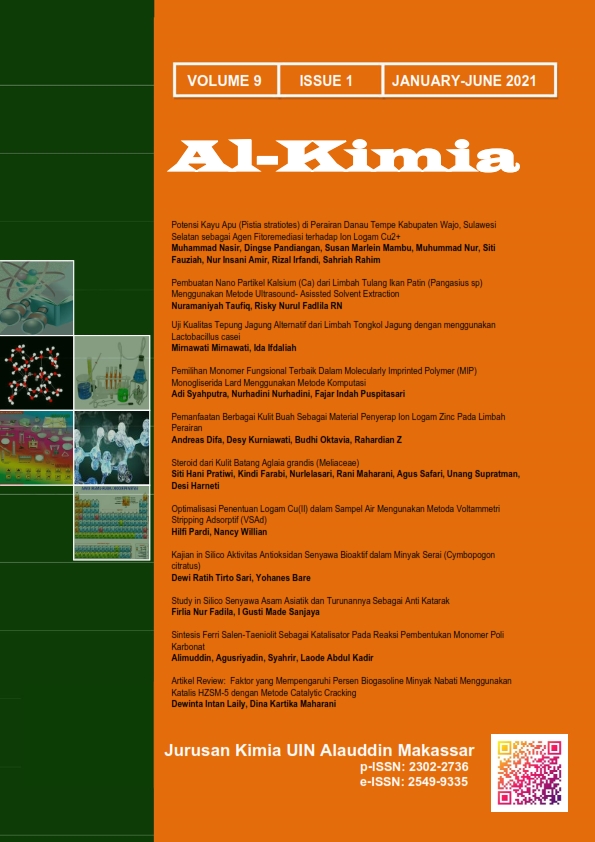Pemilihan Monomer Fungsional Terbaik Dalam Molecularly Imprinted Polymer (MIP) Monogliserida Lard Menggunakan Metode Komputasi
Abstract
Pemilihan monomer fungsional yang cocok dan dianggap relatif cukup baik selektivitasnya dalam pembuatan MIP dapat dilakukan dengan bantuan komputer (computer aided) untuk mengurangi trial and error. Dimana molekul target (template) dan monomer fungsional dimodelkan dalam bentuk 3D menggunakan software ChemBio Ultra 12 selanjutnya diinteraksikan menggunakan software AutoDock Tools 1.5.6 dan Pyrx untuk melihat binding interaction yang terjadi dan binding energy serta kemiripan sifat polaritas yang secara teoritis dapat memberikan informasi sebelum dilakukan sintesis MIP. Seleksi monomer fungsional secara bertahap dilakukan berdasarkan ada tidaknya binding interaction, tahap berikutnya dilihat berdasarkan binding energy yang paling besar (negatif) dan terakhir adalah momen dipol. Berdasarkan data tersebut monomer fungsional terpilih adalah molekul Benzo-15-crown-5-acrylamide dengan binding Interaction berupa ikatan hydrogen serta nilai binding energy dan momen dipol paling besar.Downloads
References
Amin. S., et. al, 2018, Synthesis and Characterization Molecularly Imprinted Polymers for Analysis of Dimethylamylamine Using Acrylamide as Monomer Functional, Jurnal Kefarmasian Indonesia, 8(2):76-84
Chen. L., et. al, 2016, Molecular Imprinting: Perspectives and Applications Review Article, Cem. Soc. Rev, 45, 2137
Guć. M and Grzegorz. S., 2017, The Molecularly Imprinted Polymers. Influence of Monomers on The Properties of Polymers - A Review, World Journal of Research and Review (WJRR), 5, 6, 36-47.
Heliawati. L, 2004, Identifikasi Lemak Babi Dalam Daging Olahan Berdasarkan Derivat Trigliseidanya Dengan Menggunakan Kromatografi Gas – Cairan, Jurnal Aplikasi Sains Vol.7 No.1 17-22.
Karim. K., et. al, 2005, How to Find Effective Functional Monomers for Effective Molecularly Imprinted Polymers? Advanced Drug Delivery Reviews 57, 1795-1808.
Lorenzo. C.A and Concherio A, 2013, Handbook of Molecularly Imprinted Polymers, United Kingdom, Smithers Rapra Technology.
Rahayu. W.S. et. al, 2018, Application of FTIR Spectroscopy and Chemometrics for Halal Authentication of Beef Meatball Adulterated with Dog Meat, Indones. J. chem., 18 (2), 376-381
Saputra. A, et. al., 2013, Penggunaan Metode Semiempirik AM1 Untuk Pemilihan Monomer Fungsional Efektif Pada Prasintesis Polimer Tercetak Diazinon.Valensi, 3, 1,(1-9)
Xuewen. F. et. al., 2015, Template-Monomer Interaction in Molecular Imprinting: Is the Strongest the Best?, Open Journal of Organic Polymer Materials, 5, 58-68
Yan. H, dan Kyung H. R., 2006, Characteristic and Synthetic Approach of Molecularly Imprinted Polymer, Int. J. Mol. Sci, 7, 155-178.
Copyright (c) 2021 adi syahputra

This work is licensed under a Creative Commons Attribution-NonCommercial-ShareAlike 4.0 International License.
Authors who publish with this journal agree to the following terms:
1) Authors retain copyright and grant the journal right of first publication with the work simultaneously licensed under a Creative Commons Attribution License that allows others to share the work with an acknowledgement of the work's authorship and initial publication in this journal.
2) Authors are able to enter into separate, additional contractual arrangements for the non-exclusive distribution of the journal's published version of the work (e.g., post it to an institutional repository or publish it in a book), with an acknowledgement of its initial publication in this journal.
3)Authors are permitted and encouraged to post their work online (e.g., in institutional repositories or on their website) prior to and during the submission process, as it can lead to productive exchanges, as well as earlier and greater citation of published work (See The Effect of Open Access).


